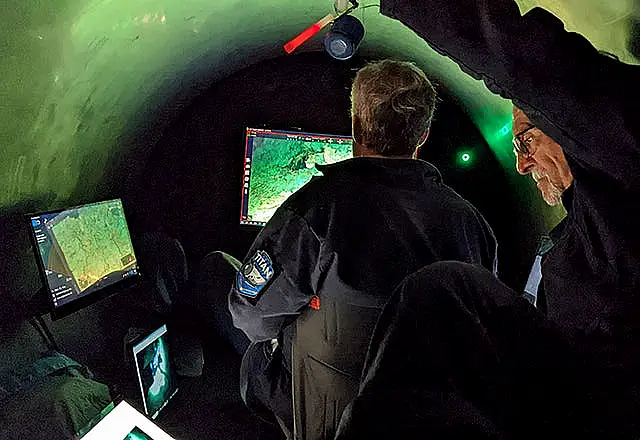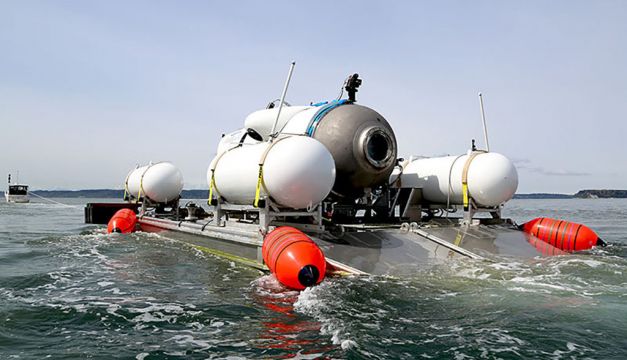Hopes were fading for the five men on board the missing Titan submersible as the 96-hour oxygen supply dwindled and experts warned the chances of their rescue were decreasing all the time.
More ships and expertise were scrambled to help find the missing deep-sea vessel, which lost communication on Sunday while about 435 miles south of St John’s, Newfoundland, during a voyage to the Titanic shipwreck off the coast of Canada.
OceanGate Expeditions estimated the oxygen supply on the 6.7m (22ft)-long vessel, which has British billionaire adventurer Hamish Harding on board, would last the crew of five 96 hours, giving rescuers a deadline of around midday on Thursday.
The US Coastguard said the French ship L’Atalante was preparing its specialist Victor 6000 ROV, which has a capacity to lift the Titan ship to the surface, to enter the water, while the Canadian vessel Horizon Arctic’s ROV had reached the sea floor.
Also in the craft are UK-based businessman Shahzada Dawood, his son Suleman Dawood, and OceanGate’s chief executive and founder Stockton Rush, as well as French submersible pilot Paul-Henri Nargeolet.

A British submariner and equipment from a UK firm has been sent to help the search at the request of the US Coastguard, Downing Street said.
Royal Navy submariner Lieutenant Commander Richard Kantharia, who was on exchange with the US Navy, has been seconded to the search and rescue team.
A No 10 spokesman said he “has significant knowledge of submarine warfare and dived operations and so he will obviously be bringing that experience to the search and rescue team”.
A British C-17 aircraft will transport “specialist commercial equipment” provided by Magellan to St John’s to assist with the search-and-rescue effort.
The French vessel L'Atalante is preparing their ROV to enter the water. #titanic
— USCGNortheast (@USCGNortheast) June 22, 2023
Advertisement
Experts said the chances of finding the sub and rescuing those inside was diminishing.
Former Royal Navy submarine captain Ryan Ramsey told the PA news agency: “The outlook is bleak, that’s the only word for it as this tragic event unfolds and almost the closing stages of where this changes from rescue to a salvage mission.”
Dr Jamie Pringle, a reader in Forensic Geosciences at Keele University, said: “I think there’s always hope with these things but you know about the golden first 24 hours and we’re well past that stage.
“So there’s always a chance, it’s never zero, but I think obviously the longer the time elapses the lower the chance of success.”
And British Antarctic Survey marine geophysicist Dr Rob Larter said: “It is just a desperate situation. It’s kind of unimaginable if people are alive trapped in a submersible with oxygen supplies running down, it doesn’t bear thinking about.
“An objective assessment of where things are at the moment – it doesn’t look good.
“You have to try and stay optimistic for as long as possible,” he added.
Prof Alistair Greig, professor of Marine Engineering at University College London, told reporters that every step takes time, adding: “This is the problem and we’re running out of time.”

The Explorers Club, of which Mr Harding is a found member of the Board of Trustees, confirmed on Thursday morning it had approval to send an (ROV) from the Channel Islands-based company Magellan to the search area.
In the statement, Richard Garriott de Cayeux, president of The Explorers Club, criticised the time it took for the approval of the ROV which has visited the Titanic wreckage previously and can go to depths as low as 6,000m.
The statement said: “Magellan is en route (should have been accepted sooner), we are still trying to get side scan sonar (should have been accepted sooner), and still working on ships to transport equipment and other details.
“We continue to come together for our friends, their families and the ideals of The Explorers Club, and the cause of safe scientific exploration of extreme environments.
“There is good cause for hope and we are making it more hopeful.”
The area of the search has been expanded, with the surface search now about 10,000 square miles, and the sub-surface search about 2.5 miles deep.
The coast guard had five surface vessels searching for Titan on Wednesday and they expected there to be 10 by Thursday, Captain Jamie Frederick said.
The Canadian vessel Horizon Arctic has deployed an ROV that has reached the sea floor and began its search for the missing sub. #Titanic
— USCGNortheast (@USCGNortheast) June 22, 2023
Asked whether the mission was changing to become a recovery search, he said: “This is a search-and-rescue mission 100%, we are smack dab in the middle of search and rescue and will continue to put every available asset that we have in an effort to find the Titan and the crew members.”
Titan is believed to be about 900 miles east and 400 miles south of Newfoundland.
It is not known how deep the vessel is, with the seabed being around 3,800m from the surface.







